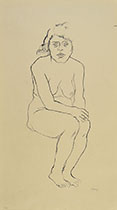Berlin 1893 - West Berlin 1959
Georg Gross, who in 1916 became George Grosz was born in 1893 in Berlin. He spends his childhood in Pomerania, and studied at the Royal Academy of Fine Arts in Dresden from 1909 to 1911, then at the School of Arts and Crafts in Berlin from 1912 to 1916. In the early 10s, George Grosz published caricatures in newspapers and magazines.
In 1913 he went to Paris where he met the painter Jules Pascin. He volunteered for service in the army in 1914; he was reformed in 1915 due to injuries, mobilized again in 1917 and finally reformed the following year due to depression. From 1915, Grosz translates his war experience into violent expressionist drawings where he shows the horror and cruelty of the conflict. He is fiercely antinationalist German. He speaks English provoking and caricaturing the German people, citizens, soldiers and clergymen, carrying out a violent attack against the established order.
George Grosz participates in the formation of the Berlin Dada group in 1918 and in the same year he joins the Communist Party. He collaborates with the magazine Der Dada. The artist expresses himself through realistic or satirical drawing, painting, watercolor painting; he creates photocollages, photomontages. In 1920 his first exhibition was presented, the year in which he too exhibited at the First International Dada Fair in Berlin, an event of which he was co-founder (with John Heartfield and Raoul Hausmann); note the presence of works by Max Ernst and Otto Dix. Grosz becomes president of the Rote Gruppe (Red Group), an association of communist artists.
In the 1920s, George Grosz is one of the main representatives of the New Objectivity movement, a period in which he painted realistic portraits. The artist is repeatedly convicted of posting obscene images and profanity.
Invited to teach at the Art Students League of New York, George Grosz emigrated to the United States in 1933 (a few days before Hitler came to power) and acquired American citizenship in 1938. He mainly draws landscapes that reflect a new inner peace. In 1937 some of his works took part in the Degenerate Art exhibition organized in Berlin by the Nazi regime; his works are removed from all German museums.
In 1941 and 1942, the artist was a professor at Columbia University. George Grosz moved back to Germany (West Berlin) in June 1959, where he died in an accident a month later.
